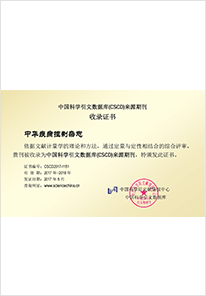2019 Vol. 23, No. 12
Display Method:
2019, 23(12): 1429-1435, 1465.
doi: 10.16462/j.cnki.zhjbkz.2019.12.001
Abstract:
2019, 23(12): 1436-1441.
doi: 10.16462/j.cnki.zhjbkz.2019.12.002
Abstract:
2019, 23(12): 1442-1447.
doi: 10.16462/j.cnki.zhjbkz.2019.12.003
Abstract:
2019, 23(12): 1455-1459.
doi: 10.16462/j.cnki.zhjbkz.2019.12.005
Abstract:
2019, 23(12): 1460-1465.
doi: 10.16462/j.cnki.zhjbkz.2019.12.006
Abstract:
2019, 23(12): 1466-1470.
doi: 10.16462/j.cnki.zhjbkz.2019.12.007
Abstract:
2019, 23(12): 1471-1475, 1481.
doi: 10.16462/j.cnki.zhjbkz.2019.12.008
Abstract:
2019, 23(12): 1476-1481.
doi: 10.16462/j.cnki.zhjbkz.2019.12.009
Abstract:
2019, 23(12): 1482-1486, 1497.
doi: 10.16462/j.cnki.zhjbkz.2019.12.010
Abstract:
2019, 23(12): 1487-1491.
doi: 10.16462/j.cnki.zhjbkz.2019.12.011
Abstract:
2019, 23(12): 1492-1497.
doi: 10.16462/j.cnki.zhjbkz.2019.12.012
Abstract:
2019, 23(12): 1503-1509.
doi: 10.16462/j.cnki.zhjbkz.2019.12.014
Abstract:
2019, 23(12): 1517-1522.
doi: 10.16462/j.cnki.zhjbkz.2019.12.016
Abstract:
2019, 23(12): 1523-1526.
doi: 10.16462/j.cnki.zhjbkz.2019.12.017
Abstract:
2019, 23(12): 1527-1530.
doi: 10.16462/j.cnki.zhjbkz.2019.12.018
Abstract:
2019, 23(12): 1531-1534.
doi: 10.16462/j.cnki.zhjbkz.2019.12.019
Abstract:
2019, 23(12): 1535-1538.
doi: 10.16462/j.cnki.zhjbkz.2019.12.020
Abstract:
2019, 23(12): 1539-1542.
doi: 10.16462/j.cnki.zhjbkz.2019.12.021
Abstract:


 Email alert
Email alert RSS
RSS Abstract
Abstract HTML
HTML PDF
PDF





